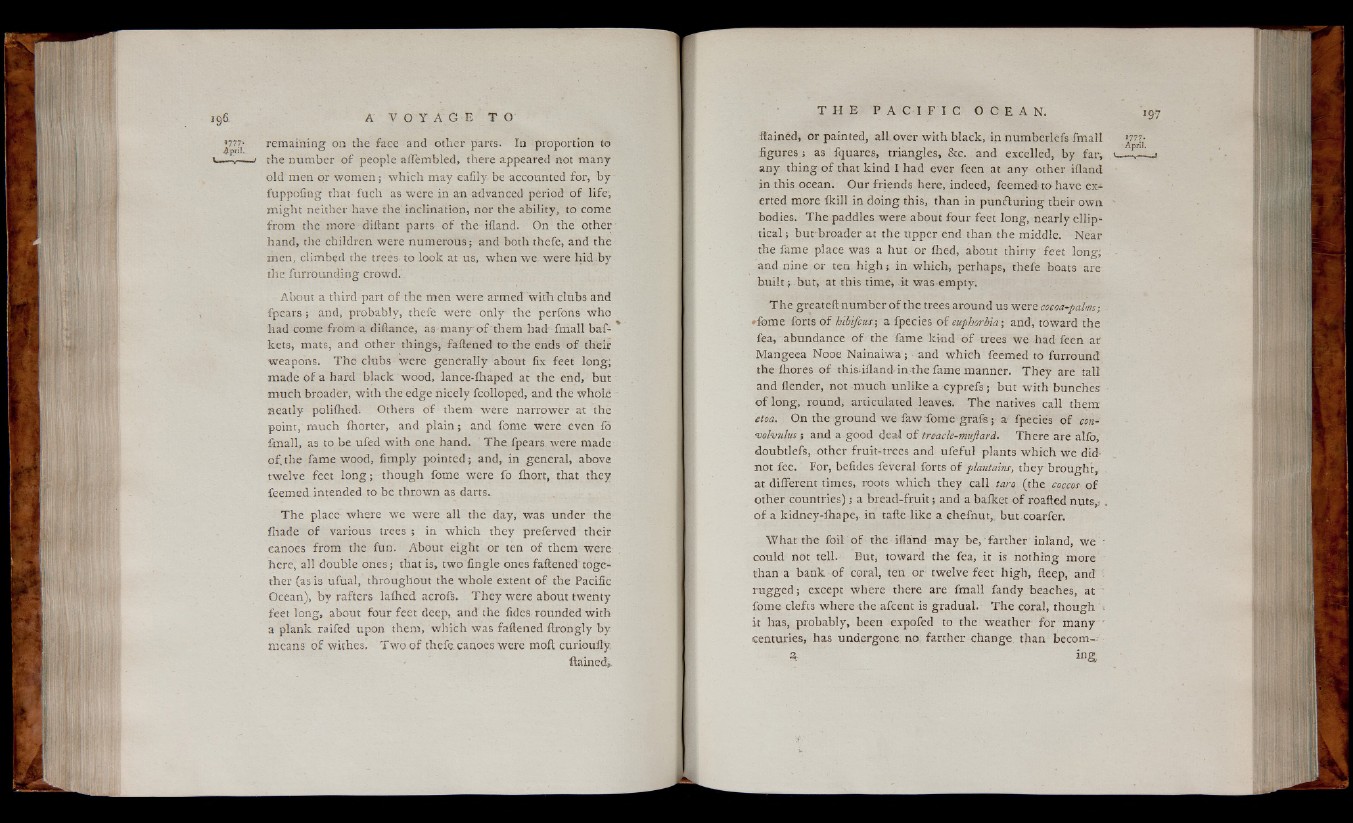
Ijn? remaining on the face and other parts. In proportion to
v— v— > the number of people affembled, there appeared not many
old men or women; which may eafily, be accounted for, by
fuppofing that fuch as were in an advanced period of life;
might neither have the inclination, nor the ability; to come
from the more diftant parts o f the ifland. On the other
hand, the children were numerous; and both thefe, and the
men, climbed the trees to look at us, when we were hid by
tile furrounding crowd.'.
About a third part of the men were armed with clubs and
fpears ; and, probably, thefe were only the perfons who
had come from a diitance, as many of them had" fmall baf-
kets, mats, and other things, fattened to the ends of their
weapons. The clubs were generally about fix feet long;
made of a hard black wood, lance-fhaped at the end, but
much broader, with the edge nicely fcolloped, and the whole
neatly polifhed. Others of them were narrower at thé
point, much fhorter, and plain ; and fome were even fô
fmall, as to be ufed with one hand. The fpears were made
of,the fame wood, limply pointed; and, in general, above
twelve feet long ; though fome were fo fhort, that they
feemed intended to be thrown as darts..
The place where we were all the day, was under the
ihade of various trees ; in which they preferved their
eanoes from the fun. About eight or ten of them were:
here, all double ones; that is, two fingle ones fattened'together
(as is ufiial, throughout the whole extent of the Pacific
Ocean), by rafters lafhed acroft. They were about twenty
feet long, about four feet deep, and the fides rounded with
a plank raifed upon them, which was fattened ftrongly by
means of withes. Two of thefe. canoes were moil curioufly.
ftained,
ftained, or painted, all.over with black, in numberlefs fmall >777.
figures; as fquares, triangles, &c. and excelled, by far, t—
any thing of that kind I had ever feen at any other ifland
in this ocean. Our friends here, indeed, feemed to have exerted
more ikill in doing this, than in punituring their own '
bodies. The paddles were about four feet long, nearly elliptical
; bur broader at the upper end than the middle. Near
the fame place was a hut or fhed, about thirty feet long; ■
and nine or ten high ; in which, perhaps, thefe boats are
built; but, at this time, it was.empty.
The greateft number of the trees around us were cocoa-palms;
»fome forts of hibifcus-, a fpecies of euphorbia; and, toward the
fea, abundance of the fame kind of trees we had feen at
Mangeea Nooe Nainaiwa; and which feemed to furround
the Ihores of thisdlland in. the fame inanner. They are tall
and flender, not much unlike a cyprefs ; but with bunches
of long, round, articulated leaves. The natives call them
etoa. On the ground we faw fome grafs; a- fpecies of convolvulus
; and a good deal of trmcle-mujlard. There are alfo,
doubtlefs,. other fruit-trees and ufeful plants which we did-
not fee. For, befides feveral forts of plantains, they brought,
at different times, roots which they call taro (the coccos of
other countries); a bread-fruit; and a baiket of retailed nuts,.«.
of a kidney-ihape, in tafte like a ehefnut,, but coarfer.
What the foil of the ifland may be, farther inland, we -
could not tell. But, toward the fea, it is nothing more
than a bank of coral, ten or twelve feet high, fteep, and
rugged; except where there are fmall fandy beaches, at ’
fome clefts where the afcent is gradual. The coral, though
it has, probably, been expofed to the weather for many '
centuries, has undergone no farther change than becom—-
1 ing,